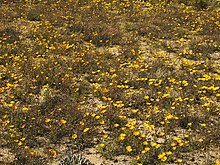Dimorphotheca
| Dimorphotheca | |
|---|---|

| |
| Dimorphotheca sinuata | |
| Scientific classification | |
| Kingdom: | Plantae |
| Clade: | Tracheophytes |
| Clade: | Angiosperms |
| Clade: | Eudicots |
| Clade: | Asterids |
| Order: | Asterales |
| Family: | Asteraceae |
| Tribe: | Calenduleae |
| Genus: | Dimorphotheca Vaill. ex Moench. |
| Synonyms[1] | |
| |
Dimorphotheca is a genus of plants in the sunflower family, native to Africa and Australia.[2] is one of eight genera of the Calenduleae, with a centre of diversity in Southern Africa. Some species can hybridize with Osteospermum, and crosses are sold as cultivated ornamentals. The name "Dimorphotheca" comes from the Greek "Dis" "Morphe" and "Theka", meaning "two shaped fruit", referring to the dimorphic cypselae, a trait inherent to members of the Calenduleae.[3] Plants of this genus usually have bisexual flowers.
- Species[1]
- Dimorphotheca cuneata
- Dimorphotheca fruticosa
- Dimorphotheca jucunda
- Dimorphotheca pluvialis ("Ox-Eye daisy", "Cape Daisy", "Rain Daisy")
- Dimorphotheca sinuata ("Cape Marigold", "African Daisy", "Star of the Veldt")
References[]
| Wikimedia Commons has media related to Dimorphotheca. |
- ^ a b Flann, C (ed) 2009+ Global Compositae Checklist
- ^ Bailey, L.H.; Bailey, E.Z.; the staff of the Liberty Hyde Bailey Hortorium (1976). Hortus third: A concise dictionary of plants cultivated in the United States and Canada. New York: Macmillan.
- ^ PlantZAfrica.com, Mhlonishwa D. Dlamini, Witwatersrand National Botanical Gardens July 2002
Categories:
- Calenduleae
- Asteraceae genera
- Asteroideae stubs